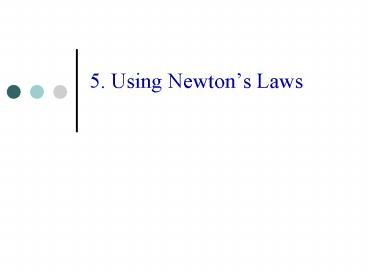5. Using Newton PowerPoint PPT Presentation
1 / 40
Title: 5. Using Newton
1
5. Using Newtons Laws
2
Newtons Third Law
3
Newtons Third Law
- Law of Action and Reaction
- Forces always occur in equal and opposite pairs
B
A
A acts on B B acts on A
4
Example 3
As noted earlier, Newtons 2nd law applies to
all macroscopic objects. In particular, it
applies to each box separately and to both boxes
together.
5
Example 3
2nd Law for m2
2nd Law for m1
3rd Law
6
Example 3
7
Example 3
The acceleration is exactly what one expects
for a mass m1m2
8
Using Newtons Laws
- General Method
- Determine the object, or objects, of interest.
- Determine real forces acting on each object.
- For each object, find the net force.
- Insert the net force into the 2nd law and solve
9
Multiple Objects
10
Example Saving a Climber
Newtons 2nd law applies to each climber For
this example, we assume no friction rope does
not stretch rope of negligible mass
11
Example (2)
- Forces on climber Steve
- Gravity
- Normal force
- Tension in rope
- Forces on climber Paul
- Gravity
- Tension in rope
12
Example (3)
Steve
Paul
1. Choose coordinate system for
each climber. 2. Sum forces for each and apply
2nd law.
13
Example (4) Steve
Steve
14
Example (5) Paul
Paul
Note for Paul, we have chosen a frame of
reference with x pointing down.
15
Example (6)
As usual, we equate components. But for this
problem only the x components are relevant
Steve Paul
16
Example (7)
By assumption
Therefore,
Steve Paul
17
Example (8)
Acceleration
Rope tension
18
Circular Motion
19
Circular Motion
is a unit vector that points from the center of
the circle to the object.
is the velocity of the object. As the
object moves around the circle, the direction of
the velocity changes as does the direction of the
unit vector .
20
Circular Motion
The acceleration is directed towards the center
of the circle, that is, it is centripetal,
and its magnitude is
21
Example 5.7 Loop-the-Loop!
What is the minimum speed needed to
guarantee that a roller-coaster car stays on the
track at the top of the loop?
- Identify forces on car
- Gravity
- Normal force from track
22
Example 5.7 (2)
We have just seen that to move in a circle,
an object must have a centripetal
acceleration. According to the 2nd law, the
acceleration is caused by a net force.
23
Example 5.7 (3)
Since the acceleration is in the same direction
as the net force, it follows that the net force
must be centripetal, that is, directed towards
the center of the loop. What are these forces?
24
Example 5.7 (4)
Presumably, they must be the two forces we have
identified the weight and the normal force.
As usual, we need to set up a coordinate system.
25
Example 5.7 (5)
Coordinate system Take y to be downwards
Take x to the right
26
Example 5.7 (6)
At the top of the loop, the normal force and the
gravitational force point downwards and towards
the center of the circle. Therefore, in the y
direction
27
Example 5.7 (7)
Solving for v we get
At the minimum speed the car is on the verge of
leaving the tracks at the top of the loop. This
occurs when the normal force, n, is zero!
28
Friction
29
The Nature of Friction
- Friction is an electrical force between the
molecules of surfaces in contact. - Unlike gravity, however, friction is a very
complicated force to describe accurately.
30
The Nature of Friction
- But, for many everyday situations, such as
dragging an object along a floor, we can describe
frictional forces using simple, approximate, - expressions.
31
Frictional Forces
- Static Friction This is the frictional force
between surfaces that are at rest relative to
each other. The maximum static frictional force
is found to be - fs µs n
- where n is the magnitude of the normal force.
µs is called the coefficient of static friction.
32
Frictional Forces
- Kinetic Friction This is the frictional force
between surfaces that are moving relative to each
other. Its value is found to be - fk µk n
- where n is the magnitude of the normal force.
µk is called the coefficient of kinetic friction.
33
Frictional Forces
- It is found that as the applied force increases
so does the opposing frictional force until a
maximum value is reached. When the applied force
exceeds the maximum frictional force the object
accelerates. - During acceleration the frictional force
decreases and remains constant when the motion is
constant.
34
Frictional Forces
Maximum frictional force Accelerating
ms n
mk n
Frictional force
Constant speed
At rest
Time
Frictional force remains equal to and opposite
the applied force.
35
Friction in Action
Without friction it would be impossible to walk
or make a vehicle move.
As you push against the ground, the ground pushes
you forwards!
36
Example Dragging a Box
What rope tension is needed to move the box
at constant velocity, assuming a coefficient of
kinetic friction µk between box and floor?
37
Example Dragging a Box
Draw free-body diagram for box. The magnitude of
the kinetic friction force is fk µk n
38
Example Dragging a Box
The motion is constant, so the forces cancel
fk T cos? 0 (x-dir.) mg n T sin?
0 (y-dir.)
39
Example Dragging a Box
The magnitude of the tension is therefore
40
Summary
- Big Idea A net force causes changes in motion.
- How to Apply
- Find all real forces on a body, sum them, and
apply Newtons 2nd and 3rd laws. - Frictional force
- Increases until object moves, then reduces and
remains constant when motion is constant.

